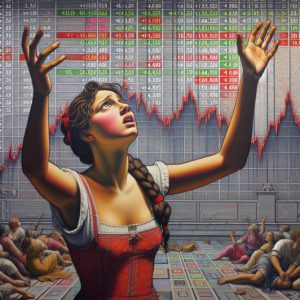
The Risk to Reward Ratio Dilemma: A Contrarian Perspective
Updated June 2023
The risk to reward ratio, a fundamental concept in the world of investing, is often misunderstood or overlooked by the masses. It is a simple yet powerful tool that can help investors make informed decisions, especially during periods of market volatility. The ratio compares an investment’s potential loss (risk) to the potential gain (reward). A favourable risk to reward ratio is often found in the aftermath of a market crash, where high-quality stocks are available at discounted prices.
In such scenarios, the market’s technical outlook is typically oversold, indicating that most stocks have been heavily sold off. This overselling often leads to a state of panic among the masses, a psychological phenomenon that contrarian investors can exploit. Contrarian investing, as the name suggests, goes against prevailing market trends. It is based on the belief that the crowd often gets it wrong and that the best investment opportunities arise when the masses are most fearful.
The mass mindset, driven by fear and greed, tends to overreact to market events. This overreaction often leads to mispriced assets, providing savvy investors with lucrative investment opportunities. For instance, during a market crash, the crowd’s fear-driven selling often results in high-quality stocks being undervalued. This presents a favourable risk to reward ratio for contrarian investors who are willing to buy when everyone else is selling.
However, contrarian investing is not without its challenges. It requires a deep understanding of market dynamics, a disciplined approach to investing, and the courage to go against the crowd. Moreover, timing the market is notoriously difficult, even for seasoned investors. Therefore, while the risk to reward ratio can provide valuable insights, it should not be used in isolation. It should be complemented with thorough research and analysis and used in conjunction with other investment strategies and tools.
In conclusion, the risk to reward ratio, when used effectively, can help investors navigate the turbulent waters of the stock market. It can provide a roadmap to finding good investments, especially when combined with an understanding of mass psychology and a contrarian investment approach. However, like all investment strategies, it requires patience, discipline, and a willingness to go against the crowd.
Every Bull Market Experiences One Strong Correction.
All bull markets experience this. Bitcoin experienced this, and then it went on to surge to new highs, and when everyone thought that things would only get better, the bottom dropped out. When the bottom dropped out, it appeared that it was another buying opportunity, but what was different at that time was that the masses were not fearful when Bitcoin started to pull back; in fact, they embraced those pullbacks.
Even today, individuals are still predicting that Bitcoin could end the year at 15,000 when 3,000 is closer to the truth. Bull markets always end on a note of euphoria; therefore, until the crowd is ecstatic, the pullbacks ranging from mild to strong must be viewed through a bullish lens unless the trend turns. We have yet to see the trend change when the masses are in disarray.
Now, let’s look at the risk Component of the equation.
All investors talk about wanting to get into a low-risk opportunity. However, when do they start to obsess about risk when the market is tanking? Remember the Tulip Mania of the 17th century? What about the Stock Market crash of 1929 or the 1987 stock market crash? Let’s move closer to the current timeline: the housing crash in 2008 and the Bitcoin crash that occurred earlier this year. To date, over $700 billion has been wiped from that sector. On what note (sentiment) did the bull get shot in every instance? The crowd was ecstatic; they were sure the markets would go higher. It appears that the mass mindset has a problem with gauging opportunity and risk; it seems to confuse one for the other.
The solution to the Risk to Reward ratio Dilemma Most Investors Face
So we know that opportunity is defined as “A favourable juncture of circumstances or A good chance for advancement or progress”. Hence, by logic, would one not be better off by not following the directives of the Mass Mindset? How could you spot an opportunity when everyone is ready to act in the same manner at precisely the exact moment? Would one not be better off diverging and taking a different route?
How could one lower risk when ready to buy at a price often double what one deemed before (before could mean one month, one year, etc.)? Why did this person not buy one year ago when the market pulled back firmly but is now willing to pay a much more significant sum when the market and the stock are trading significantly higher? What happened to the concept of risk?
The average trader has a convoluted view of the markets and the world
They are forever willing to bend the definition of risk and opportunity to suit whatever perspective takes the lead role. The solution is to spot this trait, and how does one attain this goal? By keeping a real-time diary of how you feel when the markets are soaring, especially when they pull back sharply.
A crash is a perception based on when you open the long positions. It could be a pullback to one trader because he got in low, while it’s the end of the world to the one who got in right at the top. Keeping a notebook lets you read what is going through your mind in real-time. When the dust settles, you will spot a unique pattern and be able to change. It is not too late to keep that diary; panic is running high, and the masses are unsure what to expect.
Market Crashes Operate under the same theme.
Sit back and reflect slowly; go through all the crashes you have experienced, and you will see the above theme in action in every single instance. There has never been an exception, and you would think by now that the masses would have finally learned something, but alas, this is not to be. The masses are always willing to be used as cannon fodder, and the Wall Street players know this too well.
Hence, they put the same game plan into action repeatedly; when it comes to investing, it’s Groundhog Day every day for most investors. They refuse to accept that there is another possibility. They refuse to alter the angle of perception, and by doing so, they are trapped in a prison of their making. Plato’s allegory of the cave perfectly exemplifies how the mass mindset operates. For those unfamiliar with that concept, we covered this and the topic of psychological manipulation in this article, Psychological deception techniques employed by Wall Street.
Distorted view of the risk-to-reward ratio concept
The average trader often exhibits a flawed perspective on market dynamics. They believe it’s the wrong time to buy when prices are low, assuming prices will continue declining. Conversely, when prices are soaring, they think it’s the right time to buy, expecting even higher gains. The concept of risk-to-reward ratio is disregarded despite claiming to seek low-risk opportunities. In reality, their actions contradict their stated intentions. It’s worth noting that no bull market has ever concluded in a state of fear; they end when the crowd is euphoric and overly optimistic.
It is crucial to differentiate between a battle and a war. In a fight, it is possible to lose several battles and still emerge victorious or win many battles and still lose the overall war. The determining factor lies in the amount of damage incurred rather than the simple outcome of individual actions. By minimizing the injury sustained, one can withstand consecutive losses, retreat, regroup, and ultimately achieve victory in the larger war.
Every Bull Market’s Rollercoaster Ride: Navigating the Shakeout
The exact timing of market events is unpredictable. It is important to differentiate between a shakeout phase and the market reaching a long-term top. The major players in the market require willing buyers to sell their stocks before they can cash out.
In contrast to a shakeout phase, a topping degree can be identified based on market sentiment. During this phase, the general public remains unusually resilient even when the market undergoes a significant correction. They have been led to believe that every pullback is a buying opportunity. When this belief becomes widespread, it is often a signal to exercise caution. A notable example is Bitcoin, where the general public remained optimistic despite its substantial decline. Experts continued to issue lofty price targets even when Bitcoin was trading below $5,000, implying that the odds of it dropping to $3,000 were higher than reaching $15,000.
Once you grasp this simple concept, I encourage you to read the following article as it builds upon the ideas presented here. Risk and Opportunity: When To Buy & When To Run
Originally published on November 28, 2018, this content has been consistently updated over the years, with the most recent update conducted in June 2023.
Beyond the Headlines: Articles That Offer In-Depth Analysis

Are Doppelgangers Real: Enter the Age of AI Identity Replication

Dogs of the Dow 2024: Barking or Ready to Bite?

What happens when the stock market crashes? Opportunity!

The Trap: Why Is Investing in Single Stocks a Bad Idea?

How Can Stress Kill You? Unraveling the Fatal Impact

Investment Pyramid: A Paradigm of Value or Risky Hail Mary?

Contrarian Investing: The Art of Defying the Masses

Quantitative Easing: Igniting the Corruption of Corporate America

Uranium Market Outlook: Prospects for a Luminous Growth Trajectory

Stock Investing for Kids: Surefire Path to Success!

An Individual Who Removes the Risk of Losing Money in the Stock Market: A Strategic Approach

Palladium Forecast: Unveiling the Stealth Bull Market

I Keep Losing Money In The Stock Market: Confronting the Stupidity Within

Is Value Investing Dead? Shifting Perspectives for Profit

Analyzing Trends: Stock Market Forecast for the Next 6 Months
The Ideal time to Buy Stocks is when the Masses are Panicking.


